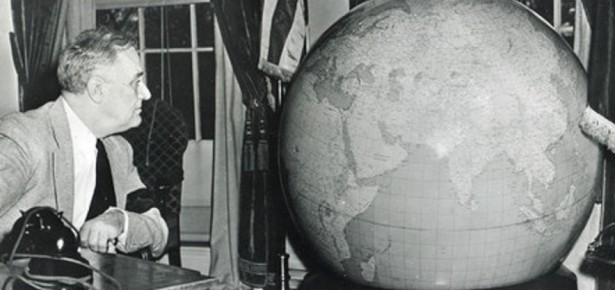
For midshipmen at the United States Naval Academy at Annapolis, the social highlight of their second year is the Ring Dance. It is an event replete with tradition and symbolism during which the midshipman’s class ring is ceremonially dipped in a brass binnacle filled with water from world’s oceans; the ceremony makes it clear that the young officer can expect to see service in all of them. It is surely, as Life magazine described it in 1939, an “odd custom,” but it is one that could only be practiced – and taken seriously – by the navy of a world dominant power. It was not always thus. When the Ring Dance was first held in 1925, the binnacle was filled only with water from the “three U.S. seas” – the Atlantic, Pacific, and Caribbean – representing the waters in which the bulk of an officer’s service might be performed and reflecting the essentially defensive posture of U.S. strategy. Water from the rest of the world’s great waterways – the Mediterranean Sea and the Indian and Arctic Oceans – was added in 1944 as U.S. military might overspread the globe. The meaning was clear; as one French official noted warily, the “change symbolized that the United States had assumed the role of world power.”
By the end of World War II, the Mediterranean had become, as writer on geopolitical affairs Joseph Roucek bluntly described it in 1953, an “American lake.” As the fighting ended, Washington moved quickly to consolidate its newly won regional dominance, utilizing the necessity of returning the body of the recently deceased Turkish ambassador to his homeland to dispatch the fast battleship Missouri to the Mediterranean in early 1946. The ensuing “battleship cruise” furnished, in U.S. ambassador to Greece Lincoln MacVeagh’s ponderous phrase, an “ocular demonstration of America’s naval strength” in and around the landlocked sea. The Missouri’s demonstrative voyage was widely interpreted as a symbol of Washington’s undisputed control over the Mediterranean and as a token of its willingness to confront the perceived extension of Russian influence into the so-called northern-tier countries of Greece, Turkey, and Iran. It also signified that the mantle of senior partner in the region was passing from Britain , the prewar hegemon, to the United States.
In October 1946, Washington further strengthened its naval presence, deploying the new aircraft carrier Franklin D. Roosevelt to the Mediterranean and using it to project dramatic displays of air power over actual or potential trouble spots from Athens to Algiers. From then on at least one aircraft carrier battle group – the basic unit of modern naval power projection – would be permanently on station in the Mediterranean. In 1948, the U.S. Navy recognized the region’s strategic importance by establishing the Sixth Fleet, headquartered in Naples and drawing on numerous wartime base and port facilities established in the Mediterranean. Throughout the Cold War, the Sixth Fleet operated an average of forty major warships in the Mediterranean. In the immediate postwar period, the Air Force followed suit, reactivating wartime airbases from Casablanca to Wheelus Field, Libya, and securing air transit rights through a corridor linking Morocco to the Philippines. In 1954, the first nuclear weapons to be based outside of the United States were sent to U.S. forces in Morocco, and the same year American-led exercises rehearsed a coordinated naval, air, and nuclear response to a projected Russian incursion into the Mediterranean.
These moves consolidated U.S. military predominance in the Mediterranean, strengthened the “southern flank” of the newly formed North Atlantic Treaty Organization (NATO), and provided Washington with a strategic “ace in the hole” with which to project power into Europe. This military force structure rested not only on the successful and large-scale deployment of armed forces in the Mediterranean during World War II, but also on the broad-fronted advance of U.S. political and economic interests with which it was inevitably intertwined. This presence was evident throughout the Mediterranean basin, from the sprawling U.S. military bases in Morocco to burgeoning commercial investment in Egypt, and from accelerating intervention in Italian politics to blunt the electoral challenge of the Communist Party to the discrete contacts with Franco’s Spain that by 1953 would result in Madrid’s de facto membership in NATO .
Download the full excerpt here.
Latest Comments
Have your say!